Lin Shao
LiDARDraft: Generating LiDAR Point Cloud from Versatile Inputs
Dec 23, 2025

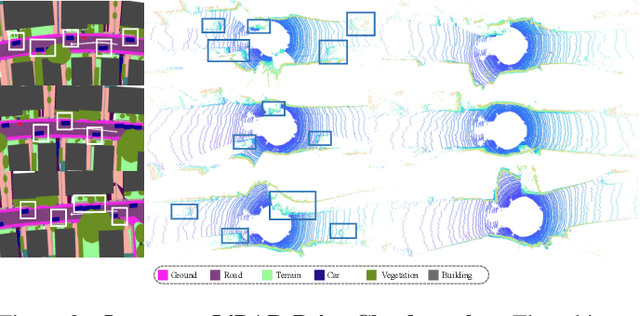

Abstract:Generating realistic and diverse LiDAR point clouds is crucial for autonomous driving simulation. Although previous methods achieve LiDAR point cloud generation from user inputs, they struggle to attain high-quality results while enabling versatile controllability, due to the imbalance between the complex distribution of LiDAR point clouds and the simple control signals. To address the limitation, we propose LiDARDraft, which utilizes the 3D layout to build a bridge between versatile conditional signals and LiDAR point clouds. The 3D layout can be trivially generated from various user inputs such as textual descriptions and images. Specifically, we represent text, images, and point clouds as unified 3D layouts, which are further transformed into semantic and depth control signals. Then, we employ a rangemap-based ControlNet to guide LiDAR point cloud generation. This pixel-level alignment approach demonstrates excellent performance in controllable LiDAR point clouds generation, enabling "simulation from scratch", allowing self-driving environments to be created from arbitrary textual descriptions, images and sketches.
ManiLong-Shot: Interaction-Aware One-Shot Imitation Learning for Long-Horizon Manipulation
Dec 18, 2025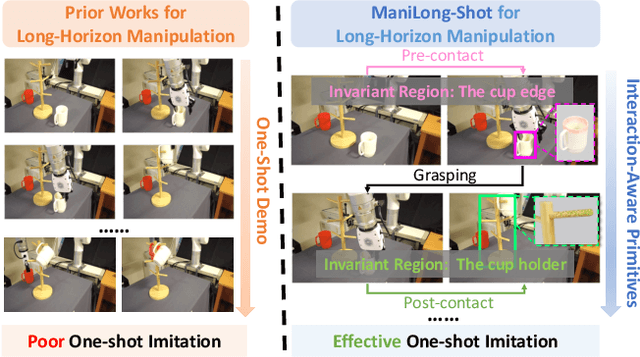

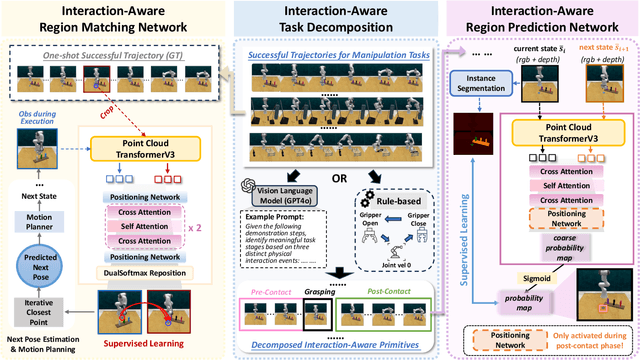
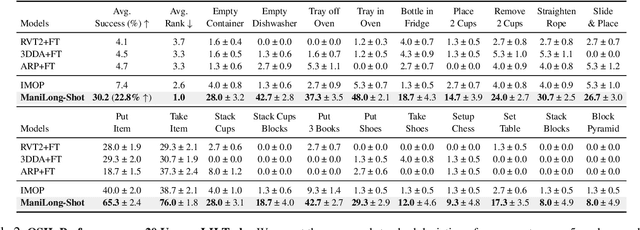
Abstract:One-shot imitation learning (OSIL) offers a promising way to teach robots new skills without large-scale data collection. However, current OSIL methods are primarily limited to short-horizon tasks, thus limiting their applicability to complex, long-horizon manipulations. To address this limitation, we propose ManiLong-Shot, a novel framework that enables effective OSIL for long-horizon prehensile manipulation tasks. ManiLong-Shot structures long-horizon tasks around physical interaction events, reframing the problem as sequencing interaction-aware primitives instead of directly imitating continuous trajectories. This primitive decomposition can be driven by high-level reasoning from a vision-language model (VLM) or by rule-based heuristics derived from robot state changes. For each primitive, ManiLong-Shot predicts invariant regions critical to the interaction, establishes correspondences between the demonstration and the current observation, and computes the target end-effector pose, enabling effective task execution. Extensive simulation experiments show that ManiLong-Shot, trained on only 10 short-horizon tasks, generalizes to 20 unseen long-horizon tasks across three difficulty levels via one-shot imitation, achieving a 22.8% relative improvement over the SOTA. Additionally, real-robot experiments validate ManiLong-Shot's ability to robustly execute three long-horizon manipulation tasks via OSIL, confirming its practical applicability.
LISN: Language-Instructed Social Navigation with VLM-based Controller Modulating
Dec 10, 2025Abstract:Towards human-robot coexistence, socially aware navigation is significant for mobile robots. Yet existing studies on this area focus mainly on path efficiency and pedestrian collision avoidance, which are essential but represent only a fraction of social navigation. Beyond these basics, robots must also comply with user instructions, aligning their actions to task goals and social norms expressed by humans. In this work, we present LISN-Bench, the first simulation-based benchmark for language-instructed social navigation. Built on Rosnav-Arena 3.0, it is the first standardized social navigation benchmark to incorporate instruction following and scene understanding across diverse contexts. To address this task, we further propose Social-Nav-Modulator, a fast-slow hierarchical system where a VLM agent modulates costmaps and controller parameters. Decoupling low-level action generation from the slower VLM loop reduces reliance on high-frequency VLM inference while improving dynamic avoidance and perception adaptability. Our method achieves an average success rate of 91.3%, which is greater than 63% than the most competitive baseline, with most of the improvements observed in challenging tasks such as following a person in a crowd and navigating while strictly avoiding instruction-forbidden regions. The project website is at: https://social-nav.github.io/LISN-project/
AdaptPNP: Integrating Prehensile and Non-Prehensile Skills for Adaptive Robotic Manipulation
Nov 14, 2025Abstract:Non-prehensile (NP) manipulation, in which robots alter object states without forming stable grasps (for example, pushing, poking, or sliding), significantly broadens robotic manipulation capabilities when grasping is infeasible or insufficient. However, enabling a unified framework that generalizes across different tasks, objects, and environments while seamlessly integrating non-prehensile and prehensile (P) actions remains challenging: robots must determine when to invoke NP skills, select the appropriate primitive for each context, and compose P and NP strategies into robust, multi-step plans. We introduce ApaptPNP, a vision-language model (VLM)-empowered task and motion planning framework that systematically selects and combines P and NP skills to accomplish diverse manipulation objectives. Our approach leverages a VLM to interpret visual scene observations and textual task descriptions, generating a high-level plan skeleton that prescribes the sequence and coordination of P and NP actions. A digital-twin based object-centric intermediate layer predicts desired object poses, enabling proactive mental rehearsal of manipulation sequences. Finally, a control module synthesizes low-level robot commands, with continuous execution feedback enabling online task plan refinement and adaptive replanning through the VLM. We evaluate ApaptPNP across representative P&NP hybrid manipulation tasks in both simulation and real-world environments. These results underscore the potential of hybrid P&NP manipulation as a crucial step toward general-purpose, human-level robotic manipulation capabilities. Project Website: https://sites.google.com/view/adaptpnp/home
T(R,O) Grasp: Efficient Graph Diffusion of Robot-Object Spatial Transformation for Cross-Embodiment Dexterous Grasping
Oct 14, 2025Abstract:Dexterous grasping remains a central challenge in robotics due to the complexity of its high-dimensional state and action space. We introduce T(R,O) Grasp, a diffusion-based framework that efficiently generates accurate and diverse grasps across multiple robotic hands. At its core is the T(R,O) Graph, a unified representation that models spatial transformations between robotic hands and objects while encoding their geometric properties. A graph diffusion model, coupled with an efficient inverse kinematics solver, supports both unconditioned and conditioned grasp synthesis. Extensive experiments on a diverse set of dexterous hands show that T(R,O) Grasp achieves average success rate of 94.83%, inference speed of 0.21s, and throughput of 41 grasps per second on an NVIDIA A100 40GB GPU, substantially outperforming existing baselines. In addition, our approach is robust and generalizable across embodiments while significantly reducing memory consumption. More importantly, the high inference speed enables closed-loop dexterous manipulation, underscoring the potential of T(R,O) Grasp to scale into a foundation model for dexterous grasping.
OWMM-Agent: Open World Mobile Manipulation With Multi-modal Agentic Data Synthesis
Jun 04, 2025Abstract:The rapid progress of navigation, manipulation, and vision models has made mobile manipulators capable in many specialized tasks. However, the open-world mobile manipulation (OWMM) task remains a challenge due to the need for generalization to open-ended instructions and environments, as well as the systematic complexity to integrate high-level decision making with low-level robot control based on both global scene understanding and current agent state. To address this complexity, we propose a novel multi-modal agent architecture that maintains multi-view scene frames and agent states for decision-making and controls the robot by function calling. A second challenge is the hallucination from domain shift. To enhance the agent performance, we further introduce an agentic data synthesis pipeline for the OWMM task to adapt the VLM model to our task domain with instruction fine-tuning. We highlight our fine-tuned OWMM-VLM as the first dedicated foundation model for mobile manipulators with global scene understanding, robot state tracking, and multi-modal action generation in a unified model. Through experiments, we demonstrate that our model achieves SOTA performance compared to other foundation models including GPT-4o and strong zero-shot generalization in real world. The project page is at https://github.com/HHYHRHY/OWMM-Agent
DexSinGrasp: Learning a Unified Policy for Dexterous Object Singulation and Grasping in Cluttered Environments
Apr 06, 2025Abstract:Grasping objects in cluttered environments remains a fundamental yet challenging problem in robotic manipulation. While prior works have explored learning-based synergies between pushing and grasping for two-fingered grippers, few have leveraged the high degrees of freedom (DoF) in dexterous hands to perform efficient singulation for grasping in cluttered settings. In this work, we introduce DexSinGrasp, a unified policy for dexterous object singulation and grasping. DexSinGrasp enables high-dexterity object singulation to facilitate grasping, significantly improving efficiency and effectiveness in cluttered environments. We incorporate clutter arrangement curriculum learning to enhance success rates and generalization across diverse clutter conditions, while policy distillation enables a deployable vision-based grasping strategy. To evaluate our approach, we introduce a set of cluttered grasping tasks with varying object arrangements and occlusion levels. Experimental results show that our method outperforms baselines in both efficiency and grasping success rate, particularly in dense clutter. Codes, appendix, and videos are available on our project website https://nus-lins-lab.github.io/dexsingweb/.
MetaFold: Language-Guided Multi-Category Garment Folding Framework via Trajectory Generation and Foundation Model
Mar 11, 2025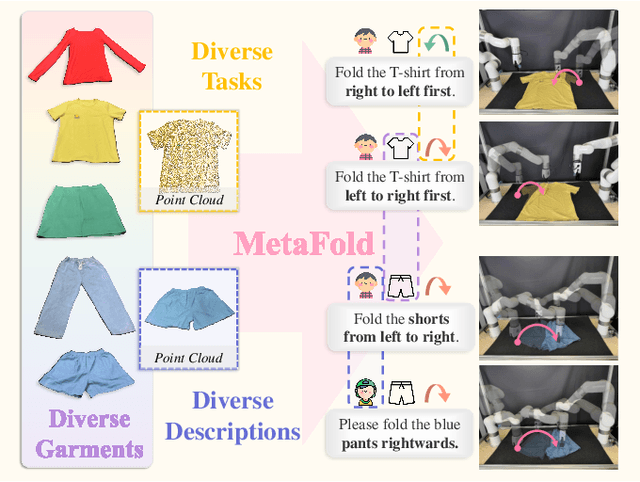
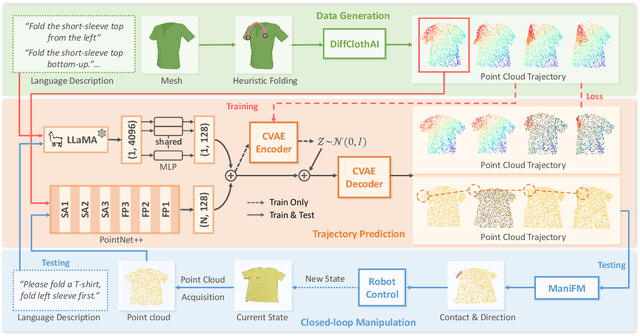
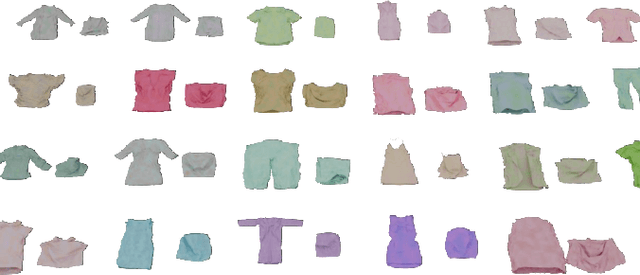
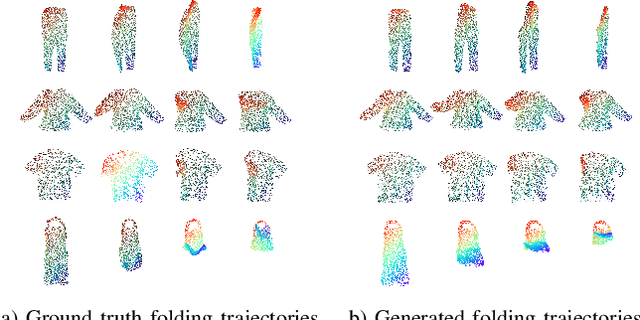
Abstract:Garment folding is a common yet challenging task in robotic manipulation. The deformability of garments leads to a vast state space and complex dynamics, which complicates precise and fine-grained manipulation. Previous approaches often rely on predefined key points or demonstrations, limiting their generalization across diverse garment categories. This paper presents a framework, MetaFold, that disentangles task planning from action prediction, learning each independently to enhance model generalization. It employs language-guided point cloud trajectory generation for task planning and a low-level foundation model for action prediction. This structure facilitates multi-category learning, enabling the model to adapt flexibly to various user instructions and folding tasks. Experimental results demonstrate the superiority of our proposed framework. Supplementary materials are available on our website: https://meta-fold.github.io/.
TelePhantom: A User-Friendly Teleoperation System with Virtual Assistance for Enhanced Effectiveness
Dec 18, 2024



Abstract:Dexterous manipulation is a critical area of robotics. In this field, teleoperation faces three key challenges: user-friendliness for novices, safety assurance, and transferability across different platforms. While collecting real robot dexterous manipulation data by teleoperation to train robots has shown impressive results on diverse tasks, due to the morphological differences between human and robot hands, it is not only hard for new users to understand the action mapping but also raises potential safety concerns during operation. To address these limitations, we introduce TelePhantom. This teleoperation system offers real-time visual feedback on robot actions based on human user inputs, with a total hardware cost of less than $1,000. TelePhantom allows the user to see a virtual robot that represents the outcome of the user's next movement. By enabling flexible switching between command visualization and actual execution, this system helps new users learn how to demonstrate quickly and safely. We demonstrate its superiority over other teleoperation systems across five tasks, emphasize its ease of use, and highlight its ease of deployment across diverse input sensors and robotic platforms. We will release our code and a deployment document on our website: https://telephantom.github.io/.
FLIP: Flow-Centric Generative Planning for General-Purpose Manipulation Tasks
Dec 11, 2024



Abstract:We aim to develop a model-based planning framework for world models that can be scaled with increasing model and data budgets for general-purpose manipulation tasks with only language and vision inputs. To this end, we present FLow-centric generative Planning (FLIP), a model-based planning algorithm on visual space that features three key modules: 1. a multi-modal flow generation model as the general-purpose action proposal module; 2. a flow-conditioned video generation model as the dynamics module; and 3. a vision-language representation learning model as the value module. Given an initial image and language instruction as the goal, FLIP can progressively search for long-horizon flow and video plans that maximize the discounted return to accomplish the task. FLIP is able to synthesize long-horizon plans across objects, robots, and tasks with image flows as the general action representation, and the dense flow information also provides rich guidance for long-horizon video generation. In addition, the synthesized flow and video plans can guide the training of low-level control policies for robot execution. Experiments on diverse benchmarks demonstrate that FLIP can improve both the success rates and quality of long-horizon video plan synthesis and has the interactive world model property, opening up wider applications for future works.
 Add to Chrome
Add to Chrome Add to Firefox
Add to Firefox Add to Edge
Add to Edge